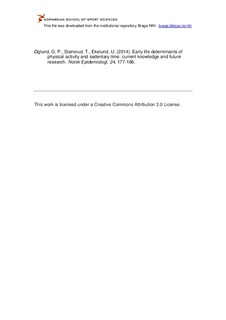| dc.contributor.author | Øglund, Guro Pauck | |
| dc.contributor.author | Stensrud, Trine | |
| dc.contributor.author | Ekelund, Ulf | |
| dc.date.accessioned | 2015-03-20T12:49:49Z | |
| dc.date.available | 2015-03-20T12:49:49Z | |
| dc.date.issued | 2014 | |
| dc.identifier.citation | Norsk epidemiologi. 2014, 24, 177-186 | nb_NO |
| dc.identifier.uri | http://hdl.handle.net/11250/280017 | |
| dc.description | This is an open access article distributed under the Creative Commons Attribution Licence, which permits unrestricted use, distribution, and reproduction in any medium, provided the original work is properly cited. | nb_NO |
| dc.description.abstract | Previous findings of the association between low birth weight and subsequent health outcomes have led to the “developmental origins of health and disease hypothesis”. Furthermore, modifiable and partly modifiable early life factors may also influence behaviors such as physical activity and sedentary behavior. The aim of the present review was to summarize the existing knowledge on early life determinants (birth weight, rapid infant weight gain, motor development and infant temperament) of childhood physical activity and sedentary time, and suggest opportunities for future research based on the Mother and Child Cohort Study (MoBa). Inconsistent results have been observed when relating birth weight to later physical activity, likely explained by differences in methodology when assessing physical activity between studies. There is limited data on whether rapid weight gain in early life predicts later physical activity and few studies have examined the association between birth weight and infant weight gain with subsequent sedentary time. Motor development may be a predictor for childhood physical activity, however methodological limitations preclude firm conclusions. The association between motor development and sedentary time has rarely been examined. Conflicting results have been reported for the association between infant temperament and subsequent physical activity and sedentary time in toddlers. Finally, it is unknown whether physical activity modifies the association between birth weight, postnatal weight gain, and later health outcomes in youth. Additional research in well-characterized birth cohorts can be used to generate new knowledge on possible early life determinants of children’s and youth’s physical activity and sedentary time which may inform evidence-based public health interventions. | nb_NO |
| dc.language.iso | eng | nb_NO |
| dc.publisher | Norsk forening for epidemiologi | nb_NO |
| dc.title | Early life determinants of physical activity and sedentary time: current knowledge and future research | nb_NO |
| dc.type | Journal article | nb_NO |
| dc.type | Peer reviewed | nb_NO |
| dc.subject.nsi | VDP::Medical disciplines: 700::Health sciences: 800::Community medicine, Social medicine: 801 | nb_NO |
| dc.subject.nsi | VDP::Medical disciplines: 700::Health sciences: 800::Epidemiology medical and dental statistics: 803 | nb_NO |
| dc.subject.nsi | VDP::Medical disciplines: 700::Health sciences: 800::Preventive medicine: 804 | nb_NO |
| dc.source.journal | Norsk epidemiologi | nb_NO |
| dc.description.localcode | Seksjon for idrettsmedisinske fag / Department of Sports Medicine | nb_NO |
